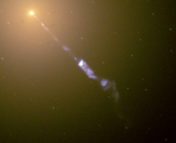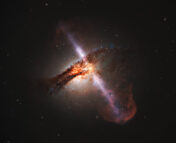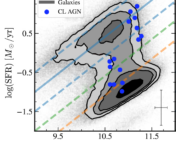Title: AGN Triality of Triple Mergers: Detection of Faint X-ray Point Sources
Authors: Adi Foord, Kayhan Gultekin, Jessie C. Runnoe, Michael J. Koss
First Author’s Institution: University of Michigan, USA
Status: Accepted to The Astrophysical Journal, Open access on arXiv
It’s the classic tale of galaxy meeting galaxy. They lock eyes across a crowded Universe, their own mutual attraction pulls them into each other’s orbits, and we watch as they get closer and closer until their inevitable violent merger. That’s how galaxies are born according to a popular theory of cosmology, known as the ΛCDM model. It argues that the structure seen in the Universe was formed hierarchically: small clumps of dark matter coalesced, which brought in gas and dust in increasing amounts until fields, groups and clusters of galaxies are produced. However, it’s not just galaxies that grow in this way. The merging is so turbulent that the supermassive black holes (SMBHs) at the galactic centres are taken along for the ride. Initially they shoot past each other, but their motion through the gas produces friction which brings them closer together. However, this friction only slows the SMBHs down enough so they can form an orbiting binary pair. Often referred to as the ‘Final Parsec problem’, without a push from an outside source these SMBHs could orbit each other forever.
One way to cross this gap is by introducing a third SMBH. This would make the gravitational interactions a lot more unstable and reduce the likelihood of creating eternally-orbiting SMBH binaries. For this reason, triple SMBH systems are thought to play an important role in black hole merging and growth, and the gravitational wave background. Simulations suggest that over 42% of massive galaxies have undergone more than one significant merger and yet only one triple SMBH system has ever been found. So, to understand more about their prevalence, today’s paper outlines a systematic search and robust identification of multiple AGN systems in nearby triple galaxy mergers.
To catch SMBHs at various stages along the merging process, today’s authors searched for signatures of active galactic nuclei (AGN) activity. This kind of activity takes the form of huge levels of emission across the electromagnetic spectrum, and is triggered by gas and dust being driven into the SMBH. Mergers are a controversial candidate for triggering AGN activity; the huge turbulence is believed to make the gas and dust more likely to reach the SMBH. Firstly, AGN from the WISE infrared catalogue were matched to a large sample of optical images from the SDSS. The authors inspected these AGN images for any signs of merging activity between three separate galaxies. From this process, they identified 12 potential systems. However, to independently identify and count individual AGN they also required X-ray data from the Chandra satellite. This additional requirement meant their sample dropped to 7 triple galaxy mergers.
The authors used BAYMAX to analyse the X-ray data, a script of their own devising which determines whether a given X-ray observation is from a single or multiple X-ray point sources. BAYMAX assessed the distribution of X-ray energy at the centre of each galaxy in the merger and compared them to an expected distribution from a varying number of X-ray sources. Using this comparison, it then calculated the Bayes factor, a ratio between the likelihood of two competing models. For this analysis, they calculate two Bayes factors: B2/1, the ratio between the double and single X-ray source models; and B3/2, the ratio between the triple and double X-ray source models. Whichever is higher determines the likely number of X-ray sources in that galaxy merger i.e. if B3/2 is greater than B2/1 then the system is believed to host 3 X-ray sources. However, if both Bayes factors were close to 0, then the merger was thought to host a single X-ray source. Of the 7 mergers in their sample, today’s authors found 1 merger system that favours a triple X-ray point source model, 5 that favour a double point source and 1 that favours a single. Encouragingly, their triple point system was the same as that which had previously been found. Figure 1 illustrates the BAYMAX process being applied to this triple point source, SDSS J0849+1114.

Figure 1: A triple galaxy merger, SDSS J0849+1114, taken by the SDSS (right), the Hubble Space Telescope (centre) and Chandra (right). The coloured boxes overlaid onto two of the images highlight the centres of each suspected X-ray point source. This is the same area over which the BAYMAX analysis was applied and suggested that this was a triple X-ray point source system.
AGN aren’t the only objects that could emit intense X-ray emission. Stars orbiting smaller black holes, known as X-ray binaries, can produce X-rays as their mass is drawn into the black hole. One way to determine the difference between these is to look at the object’s luminosity. Today’s authors use a threshold above which they argue the emission is likely to come from AGN activity. Taking this approach showed that not all of these X-ray point sources were AGN, however, they did determine that the majority of the systems host at least one AGN. Whilst X-ray activity has not been definitive, they continue this work in an accompanying paper to analyse their sample in other wavelengths.
Today’s paper represents is one of the first systematic searches for triple AGN systems in nearby triple galaxy mergers. By applying their robust statistical techniques to this large sample, they have confirmed the presence of a triple X-ray source system and found at least 4 new dual AGN systems too. Future searches for multiple AGN systems using this technique will be invaluable to test our theories of how structure in the Universe formed and how SMBHs can cross that final parsec!
Featured Image Credit: HST




